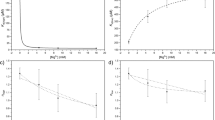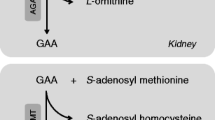Abstract
Five separate methods, paper chromatography, ethanol solubility, pH dependence, enzymatic activity, and NMR saturation transfer, were used to study the coupling of pyruvate kinase (PK) and creatine kinase (CK). Each method demonstrated specific coupling of the two proteins. The coupling with CK showed that PK had increased ethanol solubility, enzymatic activity, pH-dependent aqueous solubility, and ability to receive ATP directly from CK even at very high (1.2 M) ionic strength at equilibrium conditions. The robustness of the coupling between two enzymes with highin vivo concentrations indicates the necessity for considering kinetic schemes utilizing high enzyme concentrations, as opposed to the dilute properties of Michaelis — Menten kinetics. The direct transfer of ATP from PK to CK constitutes a net transfer of the glycolytically produced high-energy phosphate onto creatine, maintaining a high ADP and low ATP concentration in the vicinity of the glycolytic complex, conditions suited to maintaining a high glycolytic flux. The demonstration of the physical and functional coupling of two soluble enzymes, termed diazymes, suggests that glycolysis may be regulated by diazymatic coupling and that other cellular processes could be regulated similarly.
Similar content being viewed by others
References
Newsholme, E.A. and Start, C.:Regulation in Metabolism, John Wiley & Sons Ltd., Chichester, 1981, pp. 99, 104, 130–131.
Ovadi, J., Metabolic Channelling,J. Theor. Biol. 152 (1991).
Sorribas, A. and Savageau, M.A.: A comparison of various theories of intact biochemical systems. I. Enzyme-enzyme interactions and biochemical systems theory,Math. Biosci. 94 (1989), 161–193.
Marmillot, P., Hervagault, J-F., and Welch, G.R.: Patterns of spatiotemporal organization in an ‘ambiquitous’ enzyme model,Proc. Natl. Acad. Sci. 89 (1992), 12103–12107.
Smolen, P. and Keizer, J.: Kinetics and thermodynamics of metabolite transfer between enzymes,Biophys. Chem. 38 (1990), 241–263.
Srere, P.A. and Ovadi, J.: Enzyme-enzyme interactions and their metabolic role,FEBS Lett. 268 (1990), 360–364.
Srivastava, D.K., Smolen, P., Betts, G.F., Fukushima, T., Spivey, H.O., and Bernhard, S.A.: Direct transfer of NADH between alpha-glycerol phosphate dehydrogenase and lactate dehydrogenase: Fact or misrepresentation?,Proc. Natl. Acad. Sci. 86 (1989), 6464–6468.
Walsh, J.L., Keith, T.J., and Knull, H.R.: Glycolytic enzyme interactions with tubulin and microtubules,Biochim. Biophys. Act 999 (1989), 64–70.
Weber, J.P. and Bernhard, S.A.: Transfer of 1,3-diphosphoglycerate between glyceraldehyde-3-phosphate dehydrogenase and 3-phophoglycerate kinase via an enzyme-enzyme complex,Biochemistry 21 (1982), 4189–4194.
Srivastava, D.K. and Bernhard, S.A.: Enzyme-enzyme interactions and the regulation of metabolic reaction pathways,Curr. Top. Cell. Reg. 28 (1986), 1–68.
Dillon, P.F. and Clark, J.F.: The theory of diazymes and functional coupling of pyruvate kinase and creatine kinase,J. theor. Biol. 143 (1990), 275–284.
Kuby, S.A., Noda, L., and Lardy, H.A.: Adenosinetriphosphate-creatine transphosphorylase,J. Biochem. 209 (1954), 191–201.
Paul, R.J.: Functional compartmentalization of oxidative and glycolytic metabolism in vascular smooth muscle,Am. J. Physiol 244 (1983), C399-C409.
Hardin, C.D., Raeymaekers, L., and Paul, R.J.: Comparison of endogenous and exogenous sources of ATP in supporting Ca++-uptake in isolated smooth muscle plasma membrane vesicles (PMV),J. Gen. Physiol. 99 (1992), 21–40.
Meyer, R.A., Brown T.R., and Kushmerick, M.J.: Phosphorus NMR of fast and slow-twitch muscle,Am. J. Physiol. 248 (1985), C279-C287.
Brown, T.R.: Saturation transfer in living systems,Phil. Trans. R. Soc. Lond. B289 (1980), 441–444.
Czok, R. and Bücher, T.: Crystalized enzymes from the myogen of rabbit skeletal muscle,Adv. Prot. Chem. 15 (1960), 315–415.
Kurganov, B.I.: The role of multienzyme complexes in integration of cellular metabolism,J. theor. Biol. 119 (1986), 445–455.
Maughan, D. and Wegner, E.: On the organization and diffusion of glycolytic enzymes in skeletal muscle, in R.J. Paul, G. Elzinga, and K. Yamada (eds.)Muscle Energetics, Alan R. Liss, New York, 1989, pp. 137–148.
Rossi, A.M., Eppenberger, H.M., Volpe, P., Cotrufo, R., and Wallimann, T.: Muscle-type MM creatine kinase is specifically bound to sarcoplasmic reticulum and can support Ca++ uptake and regulate local ATP/ADP ratios,J. Biol. Chem. 265 (1990), 5258–5266.
Supported by USPHS Grant DK 42268.
Author information
Authors and Affiliations
Rights and permissions
About this article
Cite this article
Dillon, P.F., Weberling, M.K., Letarte, S.M. et al. Creatine kinase increases the solubility and enzymatic activity of pyruvate kinase by means of diazymatic coupling. J Biol Phys 21, 11–23 (1995). https://doi.org/10.1007/BF00701006
Received:
Accepted:
Issue Date:
DOI: https://doi.org/10.1007/BF00701006




